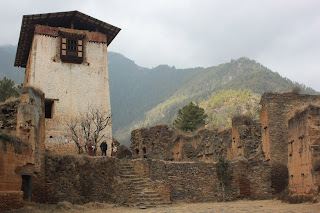Buddhas, Chortens, and Hitchhiking
With a few hours left of daylight, we headed out of the city toward Buddha Point, where one of the largest – if not the largest; it’s hard to keep track – outdoor sitting Bhuddhas resides. It was an adventure getting there walking through people’s properties, around barbed wire fences, and scrambling a few steep parts up, but it was, of course, worth it.
 I had been watching the big Buddha from the window of the room I shared with Sue everyday since we arrived in Thimpu, and it felt right to be face-to-face with him with Scott beside me. From where we stood looking out, we had a bird’s eye view of Bhutan’s largest (and very much still growing) city.
I had been watching the big Buddha from the window of the room I shared with Sue everyday since we arrived in Thimpu, and it felt right to be face-to-face with him with Scott beside me. From where we stood looking out, we had a bird’s eye view of Bhutan’s largest (and very much still growing) city.
On Sunday, we joined seven other BCF teachers and two local teenagers for a hike outside the city. Our starting point was about a 30-minute drive east out of the city to Dochu La, a mountain pass at over 10,000 feet. This is the site of 108 chortens – structures which contain Buddhist relics and is used as a place of worship – and a new temple. From there we planned on hiking for about 3-4 hours. But our plans changed. The eleven of us had piled into two taxis and were almost to our destination when the taxis slowed down for an unexpected (well, to us it was unexpected) road checkpoint. As obvious foreigners in Bhutan, you are either a tourist with a tour company, in which case the company would arrange all the route permits, or you have a work permit which proves that you live and work in Bhutan. As new teachers without official paperwork, we had neither. And the checkpoint people did not want us to proceed onto Dochu La. Two of the older guys from our group took the initiative to talk to the checkpoint people themselves and managed to negotiate a deal – while we would not be allowed to just be dropped off and hike, we could drive to Dochu La, check out the sites, and be back at the checkpoint within an hour and a half. We accepted the deal.
 Inside the temple was a feast for the eyes – painted murals depicting Bhutan’s history from the first king to a portrait of the current royal family to a group of monks huddled around a laptop; intricately carved and painted wooden pillars; crystal chandeliers; colorful silk wall hangings; elephant tusks; stones embedded into the wooden floor; large statues of three Buddhist figures, including one of Buddha himself.
Inside the temple was a feast for the eyes – painted murals depicting Bhutan’s history from the first king to a portrait of the current royal family to a group of monks huddled around a laptop; intricately carved and painted wooden pillars; crystal chandeliers; colorful silk wall hangings; elephant tusks; stones embedded into the wooden floor; large statues of three Buddhist figures, including one of Buddha himself. Supposedly on a clear day, Dochu La allows for a panoramic view of Bhutan’s Himalayan range. We were not so lucky on the weather.
Supposedly on a clear day, Dochu La allows for a panoramic view of Bhutan’s Himalayan range. We were not so lucky on the weather. A close up of a chorten.
A close up of a chorten.After visiting Dochu La and returning to the checkpoint by 1:00 pm, we had the taxis drop us off at the nearby village of Hongtsho. From there we hiked about two hours up to Trashigang Goemba, which was built in 1786. We were welcomed to the monastery by a barking dog and young monk who invited us to tour the old goemba.
 After taking off our shoes, we were allowed to tour all the rooms which were so cold we could see our breath inside. After climbing a steep set of stairs we happened upon a small group of monks who were all sitting together, barefoot, watching Bhutan Star. Some of the younger monks were both watching the TV and building yak butter statues. While the goemba itself was remarkable and intriguing, I mainly just wanted to get back outside in the warm sun.
After taking off our shoes, we were allowed to tour all the rooms which were so cold we could see our breath inside. After climbing a steep set of stairs we happened upon a small group of monks who were all sitting together, barefoot, watching Bhutan Star. Some of the younger monks were both watching the TV and building yak butter statues. While the goemba itself was remarkable and intriguing, I mainly just wanted to get back outside in the warm sun.When we hiked back down to Hongtsho, the eleven of us managed to hitchhike back to Thimpu in four different vehicles that all stopped within minutes of each other. Scott’s first weekend in Thimpu ended with a BCF group dinner at Bhutan Kitchen where we sipped bowls of ara, a local spirit also known as “Bhutanese moonshine.”


















